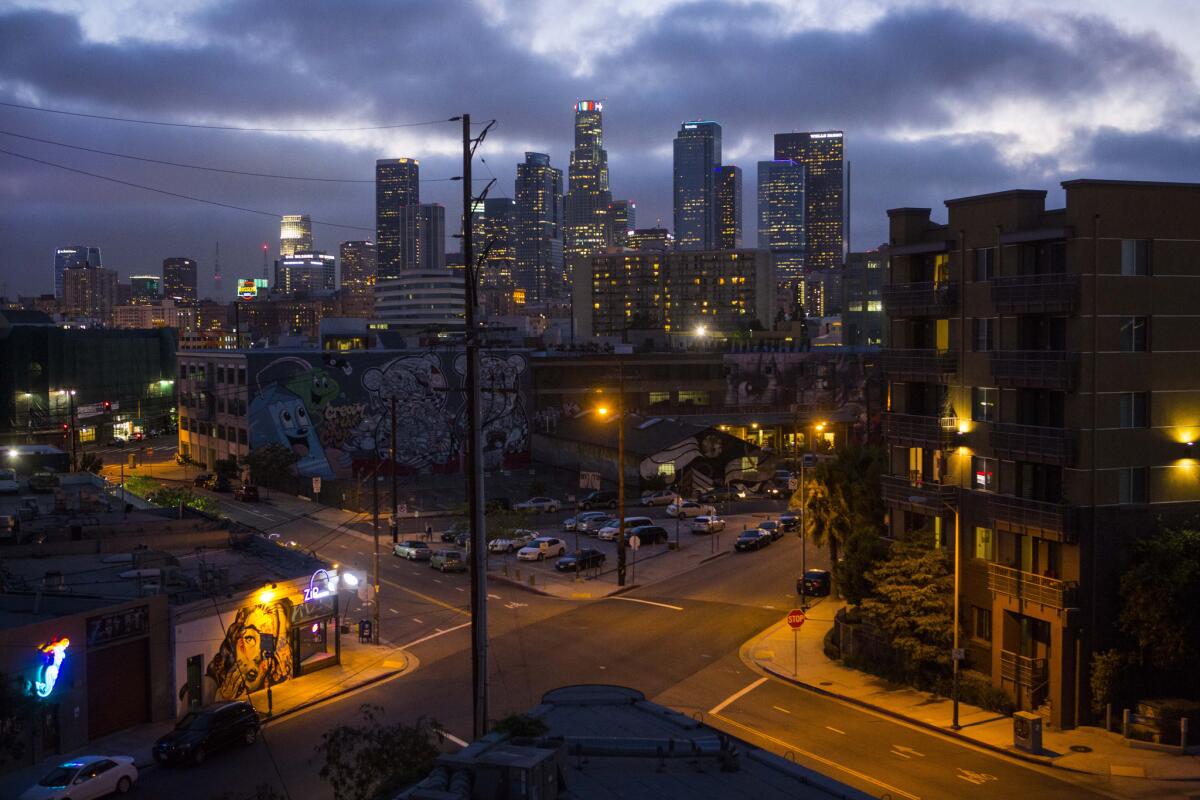Column: Now that artists can’t afford the Arts District, L.A. needs to rethink its role as a creative city

A 2014 view of Bloom’s Square Triangle at the corner of Traction Avenue and East 3rd Street. As development crescendoes in the Arts District, artists and gallerists are being pushed out.
Way back in July of last year, The Times ran a story about how development in the downtown Los Angeles Arts District — the old industrial zone between 1st and 7th Streets, east of Alameda — had long-time residents concerned about rising rents pushing out the very artists for whom the neighborhood is named.
“Don’t forget the art and the artist,” said painter Jett Jackson at the time.
What a difference 18 months make. If development in the Arts District was then at a steady simmer, it is now on super boil.
SIGN UP for the free Essential Arts & Culture newsletter >>
Look up “Arts District” on Google Maps and the first image you’ll see is the rooftop pool at the El Molino lofts. Every week seems to bring a new restaurant or bar or a “curated” boutique dispensing $1,000 watches and $40 totes.
As the real estate boom goes totally nuclear, the neighborhood’s boundaries keep informally expanding to include the area below the 10 freeway, where a number of galleries have already set up house.
Late last month, Curbed ran a (staggering) list of all the development projects in the neighborhood, which includes a mind-boggling number of lofts, hipster coffee joints, high-end restaurants, a Grove-style outdoor mall, a tech center and — the piece that has generated the most chatter — the incoming Soho House, a downtown outpost of the splashy private club.
And last week, the LA Weekly ran a report by Catherine Wagley that described how a pair of small gallery spaces on South Santa Fe are being pushed out to make way for condos (okay, “lofts”) just a year after opening.
“I’ve never seen a neighborhood change this fast,” one property owner told the Weekly in the story titled, “Is Downtown L.A.’s Art Scene Already Doomed?”
Sure, there is some art in the mix. Mega-gallery Hauser Wirth & Schimmel is expected to open a 100,000-square-foot complex in a former mill in March on Third Street. And while it will be free to visit (and the art promises to be museum-quality) this will be the sort of international blue chip space that isn’t exactly going to do anything for artists in search of cheap studios.
This is a problem.
At the moment, Los Angeles is in love with the idea of itself as a hotbed of creativity. Mayor Eric Garcetti doesn’t miss an opportunity to describe the city as “a creative capital,” as do other civic boosters. The city’s cultural scene has been relentlessly covered by media of all stripes as the Next Great Art Thing (most recently in a breathless travel story in England’s Independent).
And once a year, the Otis College of Art and Design issues a report that tabulates the economic impact of the region’s “creative economy.” This, according to the report’s authors, “provides powerful and persuasive evidence of the enormous positive fiscal impact of the creative industries across California.”
But if L.A. is going to remain a creative capital, its civic and cultural leaders are going to need to do more than offer really great talk about how great we are. We need solid ideas — and the execution of these — to keep Los Angeles a great place to be an artist.
This can start with the Otis Report on the Creative Economy.
The report is helpful as a compendium of statistics about which creative industries call California home and what their economic impact might be. But it is pretty optimistic about what constitutes a creative industry. Among the 1.4 million jobs generated (direct, indirect and induced), fields such as apparel manufacturing and wholesaling are included by the report’s authors. By that logic, all those sweatshops in Bangladesh comprise a buzzing cultural district.
If this report is to be more than just a feel-good data dump, it could use some solid recommendations on how L.A. compares to other cities culturally and how we might improve the situation for artists and cultural organizations, both small and large.
New York’s Center for an Urban Future issues a similar report (with far less frequency) on the state of the arts in that city. But “Creative New York,” as it is called, is far more comprehensive. For one, it offers data on how the city’s cultural scene fits into a larger national picture.
It covers the city’s job growth in creative sectors relative to other locations in the U.S. It breaks those jobs out by neighborhood. It addresses cost of living issues and closures of cultural spaces, as well as the drying up of government grant dollars. It looks at the strength of the cultural nonprofit sector and attendance figures in the performing arts.
It provides a holistic picture of the city’s various cultural assets within a local and national context. In fact, it was in reading “Creative New York” that I found out how much Los Angeles County seriously lags when it comes to share of households donating to public broadcasting or the arts. New York is number one on the list. DeKalb County, Ga., is number two. San Francisco is number three. L.A. doesn’t break the top 10. (For shame, El Lay. For shame.)
“Creative New York” also, quite helpfully, offers nine pages of concrete recommendations on what might make the city more hospitable to the arts. This includes a description of the types of programs that have successfully supplied artists with free or below-market studio space. It offers tips on how artists might better qualify for subsidized housing. It suggests ways in which the tax code can be less punitive to creative workers.
It even, quite intriguingly, discusses ways in which real estate developers and property owners might better support cultural activities by designating less lucrative second- and third-story or other off-the-street retail spaces as cultural zones that rent at below market rates.
“City officials,” the report states, “should work with local development corporations and other business organizations to develop a set of carrots and sticks that could encourage landlords to rent these spaces to arts organizations, creative sector businesses, freelancers and others with significant space needs.”
Which gets to execution.
And this is where civic and cultural leaders come in. In recent weeks, developers and civic leaders in the Arts District have been debating the minutiae of a live-work ordinance that would help preserve the character of the neighborhood by continuing to develop buildings where creative types might be able to both live and work.
But the ordinance — and the debate over it — strikes me a little bit like rearranging the deck chairs on the Titanic. What does it matter if a studio-loft has 1,000 square feet of live-work space if it is totally unaffordable?
This isn’t just a zoning question, it’s an income question. If neighborhoods such as the Arts District are to remain dynamic and true centers of arts production, we need to think not only about setting aside spaces that are functional for artists, but that are affordable to artists, too.
And by artists, I don’t mean well-paid showbiz types, programmers or the mysteriously wealthy members of the elite who can afford to dump $7 on juice. A healthy neighborhood is like a healthy ecosystem and should have a little bit of everything — including members of the working class.
This will require some carrot-and-sticking from our city leaders. That means developing incentives to build affordable housing and giving financial breaks to cultural spaces (not just of the high-end variety). This will have to come the likes of the City Council and Mayor Garcetti. And it will have to come from figures such as City Councilman José Huizar, in whose voting block the Arts District resides. Huizar, incidentally, is no stranger to development, some of which isn’t exactly known for its sensitive urban planning.
Any change at this point will likely come too late for the Arts District, which is already up to its man-buns in single-origin coffee and $9 avocado toast (the equivalent of the hourly minimum wage in the state of California). But there are still other areas of the city to consider, places that haven’t been developed to death.
A series of thoughtful, well-considered recommendations issued by an institution such as Otis in its annual report could be helpful in creating a map of what could be done in Los Angeles — not just in the Arts District — to keep the arts scene blazing.
In 2013, Mayor Garcetti posted a photo of himself to Twitter holding a sign that read #ArtsMatter, with the statement: “Let’s make sure L.A. is the creative capital of the world for years to come.”
Good idea. Let’s start by finding a way to keep the artists in town.
Find me on Twitter @cmonstah.
ALSO
Arts District Brewing craft brewpub opening soon in downtown L.A.
Jim Shaw celebrates the fabric and weirdness of America at New Museum
Miami Beach may have Art Basel, but L.A. has ‘Art Basil’ -- and it’s the pesto thing ever
More to Read
The biggest entertainment stories
Get our big stories about Hollywood, film, television, music, arts, culture and more right in your inbox as soon as they publish.
You may occasionally receive promotional content from the Los Angeles Times.











